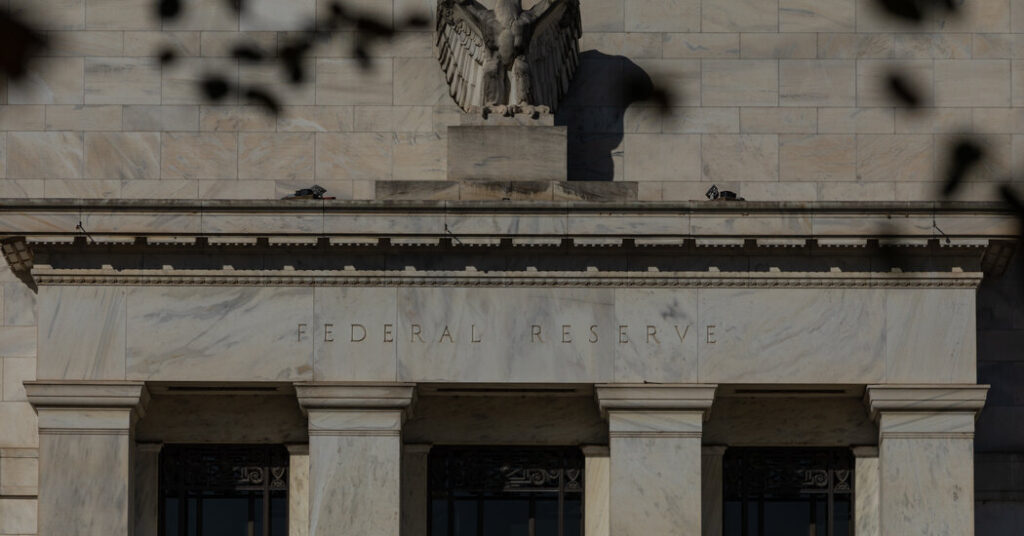Federal Reserve officials have had one clear message since President Trump sharply escalated the global trade war this month. Keeping inflation expectations in check as price pressures rise is their No. 1 priority.
On Friday, they faced a big setback.
A new survey released by the University of Michigan found that as consumer sentiment took another nosedive because of fears associated with Mr. Trump’s tariffs, expectations about inflation — in the year ahead and over a longer time horizon — jumped sharply.
Over the next 12 months, respondents now expect inflation to surge to 6.7 percent, the highest reading since 1981 and a significant increase from the March level of 5 percent. In five years’ time, they are bracing for inflation to stay stuck above 4 percent. The Fed’s goal is 2 percent inflation.
There are reasons to take this data with a grain of salt. For one, the survey tends to reflect political biases. Since Mr. Trump returned to the White House, Democrats, once optimistic about the outlook, have turned much more downbeat, about not only inflation but also growth and the labor market. Republicans, meanwhile, have flipped from being far more pessimistic during Biden’s presidency to much more positive.
On the margins, that political divide may be beginning to narrow, with the decline in sentiment in April “pervasive and unanimous across age, income, education, geographic region and political affiliation,” according to Joanne W. Hsu, director of the consumer surveys. Independents are also starting to change their opinions in a distinct way, accounting for a large part of the rise in longer-run inflation expectations.
What has helped to somewhat alleviate concerns about the survey findings is the fact that market measures of longer-run inflation expectations, which are based on U.S. government bonds, have stayed far more stable. The divergence has been so stark as to prompt Jerome H. Powell, the Fed chair, to refer to the University of Michigan survey as an “outlier,” as recently as last month.
But as the prospects of significantly higher consumer prices have grown with the escalation of the global trade war, Torsten Slok, chief economist at Apollo Global Management, an investment firm, said the Fed could not ignore the shifts taking place in inflation expectations.
“The challenge for the Fed is that it just becomes more and more difficult to downplay it, because there’s just more and more evidence,” he said.
It is no surprise then that officials at the Fed are toughening up their talk on inflation.
It’s “critically important” that inflation expectations stay stable at this time, John C. Williams, who as president of the powerful New York Fed is a permanent voter on the central bank’s policy-setting committee, said on Friday. He said he now expected inflation to rise to as high as 4 percent this year, as the unemployment rate reaches as much as 5 percent and growth dips below 1 percent.
Similar concerns were expressed by Alberto G. Musalem, the president of the St. Louis Fed and a voting member on this year’s policy-setting committee. “I would be wary of assuming the impact of higher tariffs on inflation would be only brief or limited,” he said at a separate event on Friday.
Mr. Musalem said the Fed should “lean against” the possibility that what could just be a one-off shock turns into something more persistent. “Discerning between underlying inflation and the direct, indirect and second-round effects of tariffs is likely to be challenging in real time.”
Neel Kashkari, president of the Minneapolis Fed, also said on Friday that the Fed should be “very cautious” about any moves that indicated a “weakening of the Fed’s commitment to get inflation all the way back down.”
Asked about the recent financial market turmoil — a worrisome combination of a sell-off of U.S. stocks at the same time that investors have fled the U.S. dollar for other currencies, in addition to U.S. government debt, Mr. Kashkari pushed back on the idea that the central bank needed to intervene. There are signs of stress, but no “big dislocations yet,” he said. Susan Collins, president of the Boston Fed, said the central bank would “absolutely be prepared” to stabilize financial markets if that was needed.
This tough talk is likely to translate to the Fed’s holding off on interest rate cuts until it sees actual cracks in the labor market or other tangible signs that the economy is deteriorating in a significant way.
On Thursday, Austan Goolsbee, the president of the Chicago Fed, confirmed that the bar for cuts had moved a “little higher.”
The “more people think prices are going to be up, the more risk there is that it’s not just transitory, that it gets kind of embodied in the system,” Mr. Goolsbee, who will cast a vote at policy meetings this year, told reporters.
https://www.nytimes.com/2025/04/11/business/economy/fed-inflation-trade.html


